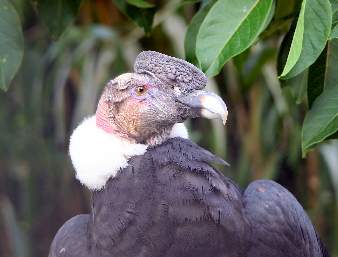|
|
|
Continued from Introduction to Condors and the California Condor
The male Andean Condor is remarkable among birds for
the large caruncle which crowns his head, like an exaggerated cock's comb,
and falling down on the culmen of the back often leaves an open space in
front of the base. This and his bare head and neck of a dull reddish
colour, wrinkled into many folds, give him a very peculiar expression.
Having the head and the neck bare stops dirt from accumulating, thus avoiding
diseases.
The hard dry appearance of the the head and neck
contrasts with the ruff of white down that separates it from the glossy
black of the rest of the plumage, except the edges of the wing-coverts
and the secondary wing-quills which are white. The beak is strong,
curved and sharp to tear to the meat of dead animals and carrion.
|

Picture of Andean Condor
|
The Andean Condor's wingspan can reach up
to 3.2 meters. Thus it possesses one of the largest spans of all birds (beside
that of the Albatross) and it is in fact the largest bird of prey in the world. With these enormous wings it usually takes advantage of the ascending airflows to glide. It can reach a flying altitude
of up to 5 or 6 km and even as high as 7 km. Thanks
to satellite tracking, it is known that the Andean Condor can fly 300 kilometers
in a single day using these immense wings.
It measures an average body length of 105 centimeters,
with some having been measured at 120 cm, and can weigh 12 kilograms.
It is used to living in groups of several tens of individuals, usually
under the control of a dominant male.
It constructs its nest in stone projections where
it lays one or two white eggs with brown spots. Incubation of the
eggs amounts to up to 65 days. Both partners are responsible for the egg.
When newly hatched, the chick is fed twice a day. After 6 months
the young bird becomes able to fly. The young animals have a brown
plumage color, which changes then to the final adult black and white colours
around the age of 8 years. Andean Condors can reach the age of 70
years old.
|
|
The Andean Condor is highly respected by may of
the peoples of South America and has inspired a number of legends.
It is the national bird of Ecuador, Colombia, Bolivia and Chile, and can
be seen on their coats of arms.
Hunting for the condor is a tradition in the Andes.
The technique of hunting is original: a cow, an ass or a horse is brought
by the hunters and killed in a rather deep and sloping geological basin.
After several days, the condor is attracted by the carcass, and approaches.
It takes its meal at the bottom of the geological basin, whilst the hunters
leave it to stuff itself full of food to weigh it down. They then
leave their hiding place while shouting and running towards the bottom
of the basin. When the hunters are rather close, they throw a net on the
condor and carry it like trophy.
This technique exploits the fact that the condor
uses a gliding flight rather than a beaten flight. When it is at the bottom
of the basin, it must make enormous efforts to succeed in taking off and
rising more steeply than the slope of the basin which surrounds it.
It is must land several times, which leaves with the hunters time to approach.
|
|
|





